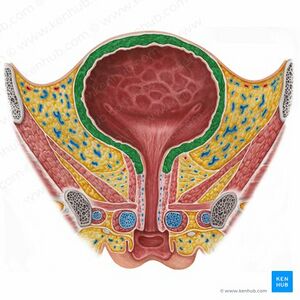Detrusor Sphincter Dyssynergia
[1]Introduction[edit | edit source]
According to the International Classification of Syndromes (ICS), detrusor sphincter dyssynergia (DSD) is "the impaired coordination between detrusor and sphincter during voiding due to a neurologic abnormality".[2]
During normal micturition, the detrusor muscle of the bladder and the striated smooth muscle of the urethral sphincter work synergistically. The urethral sphincter relaxes during this process, and the detrusor contracts to push the bladder's urine into the urethra. The pontine micturition centre, a specialised region in the caudal brainstem, is in charge of controlling this synergy between the detrusor muscle and the external urethral sphincter. DSD is frequently caused by disruption of the pathways between this region to the caudal portion of the spinal cord.[3]
DSD refers to an involuntary detrusor contraction that is accompanied by an involuntary external sphincter contraction. This condition prevents adequate voiding and may result in hydronephrosis, renal scarring, a low compliant and thick-walled bladder, elevated retrograde pressures in the ureter and pelvis, and terminal kidney failure. [3]
For more info about the anatomy of the bladder, click here.
Predisposing factors[edit | edit source]
- Multiple sclerosis (about 20-25% of people affected).[4][5]
- Spinal cord injury.[6][7]
- Spina bifida (about 50% of infants affected)[8]
- Transverse myelitis and other uncommon conditions affecting the spinobulbospinal tract.[9]
- Human T-cell Lymphotropic Virus 1 (HTLV-1).[10]
- Stroke.[11]
- ↑ Gliga LA, Lavelle RS, Christie AL, et al. Urodynamics findings in transverse myelitis patients with lower urinary tract symptoms: Results from a tertiary referral urodynamic center. Neurourol Urodyn 2015;34:507-12.
- ↑ Abrams P, Cardozo L, Fall M, et al. The standardisation of terminology of lower urinary tract function: Report from the Standardisation Subcommittee of the International Continence Society. Neurourol Urodyn. 2002;21(2):167-178.
- ↑ 3.0 3.1 Castro‐Diaz D, Taracena Lafuente JM. Detrusor‐sphincter dyssynergia. International Journal of Clinical Practice. 2006 Dec;60:17-21.
- ↑ Stoffel JT. Contemporary management of the neurogenic bladder for multiple sclerosis patients. Urol Clin North Am 2010;37:547-57.
- ↑ Araki I, Matsui M, Ozawa K, et al. Relationship of bladder dysfunction to lesion site in multiple sclerosis. J Urol April 2003;169:1384-7.
- ↑ Schurch B, Schmid DM, Karsenty G, et al. Can neurologic examination predict type of detrusor sphincter-dyssynergia in patients with spinal cord injury? Urology 2005;65:243-6.
- ↑ Bellucci CH, Wöllner J, Gregorini F, et al. Acute spinal cord injury--do ambulatory patients need urodynamic investigations? J Urol 2013;189:1369-73.
- ↑ Bauer SB, Dieppa RA, Labib KK, et al. Predictive value of urodynamic evaluation in newborns with myelodysplasia. JAMA 1984;252:650-2.
- ↑ Gliga LA, Lavelle RS, Christie AL, et al. Urodynamics findings in transverse myelitis patients with lower urinary tract symptoms: Results from a tertiary referral urodynamic center. Neurourol Urodyn 2015;34:507-12.
- ↑ Castro NM, Freitas DM, Rodrigues W, et al. Urodynamic features of the voiding dysfunction in HTLV-1 infected individuals. Int Braz J Urol 2007;33:238-44; discussion 244-5.
- ↑ Meng NH, Lo SF, Chou LW, et al. Incomplete bladder emptying in patients with stroke: is detrusor external sphincter dyssynergia a potential cause? Arch Phys Med Rehabil 2010;91:1105-9.







